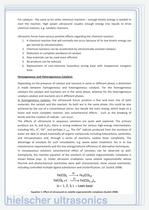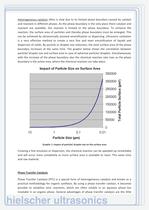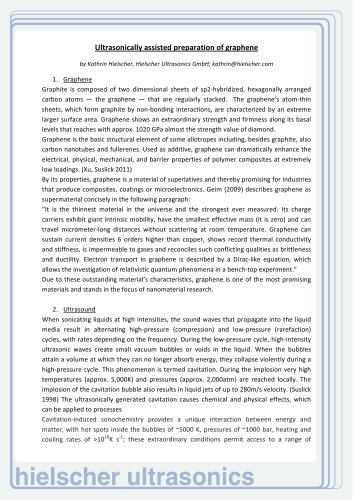
Catalog excerpts

Hielscher Ultrasonics GmbH – www.hielscher.com – info@hielscher.com Sonocatalysis – The effects of sound generated waves on catalytic chemistry Power Ultrasound During the sonication of liquids, the accoustic wavelength range between approx. 110 and 0.15 mm for frequencies of 18kHz and 10Mhz. This is significantly higher than those of molecular dimensions, resulting in that there is between the molecules and the accoustic field no direct coupling of chemical species. The effects of sonication are mostly generated by the ultrasonic cavitation in liquids (picture 1). Therefore, for the ultrasound catalysis at least one reagent in a liquid phase is necessary. Cavitation erosion on particle surfaces generates unpassivated, highly reactive surfaces. Short periods of high temperatures and pressures contribute to a molecular decomposition and increase the reactivity of many chemical substances. Ultrasonic irradiation can also be used to prepare the catalysts, e.g. to produce aggregates of fine-size particles. Picture 1: Ultrasonically generated cavitation on the sonotrode of a 1500watts ultrasonic processor (blue illuminated for better visibility) The application of power ultrasound is a well-known tool to create extremely fine emulsions and dispersions. In chemistry such extremely fine-size emulsions and dispersions are used to enhance chemical reactions. This means that the interfacial contact area between two or more immiscible liquids or between liquid and solid becomes dramatically enlarged and provides thereby a better, more complete and/or faster course of the reaction. Other useful effects, which can be achieved by ultrasonication, are the break-up of bondages and the creation of free radicals.
Open the catalog to page 1
Hielscher Ultrasonics GmbH – www.hielscher.com – info@hielscher.com For catalysis - the same as for other chemical reactions – enough kinetic energy is needed to start the reaction. High power ultrasound couples enough energy into liquids to drive chemical reaction, e.g. catalytic reactions. Ultrasonic forces have various positive effects regarding the chemical reaction: 1. A chemical reaction that will normally not occur because of its low kinetic energy can get started by ultrasonication. 2. Chemical reactions can be accelerated by ultrasonically-assisted catalysis. 3. Reduction or...
Open the catalog to page 2
Hielscher Ultrasonics GmbH – www.hielscher.com – info@hielscher.com Heterogeneous catalysis often is slow due to its limited phase boundary caused by catalyst and reactant in different phases. As the phase boundary is the only place there catalyst and reactant are available, the reaction is limited to the phase boundary. To enhance the reaction, the surface area of particles and thereby phase boundary must be enlarged. This can be achieved by ultrasonically assisted emulsification or dispersing. Ultrasonic cavitation is a very effective method to create a very fine and even emulsification...
Open the catalog to page 3
Hielscher Ultrasonics GmbH – www.hielscher.com – info@hielscher.com efforts for preparation, simple experimental procedures, mild reaction conditions and the use of inexpensive and environmentally benign reagents, such as quaternary ammonium salts, and solvents, and the possibility of conducting large scale preparations (Ooi et al. 2007). A variety of liquid–liquid and liquid–solid reactions have been intensified and made selective by using simple phase-transfer (PT) catalysts such as quats, polyethylene glycol-400, etc., which allow ionic species to be ferried from aqueous phase to organic...
Open the catalog to page 4
Hielscher Ultrasonics GmbH – www.hielscher.com – info@hielscher.com Ultrasonic Enhancement of Asymmetric Phase Transfer Reaction With the aim of establishing a practical method for the asymmetric synthesis of a-amino acids and their derivatives Ooi and Maruoka (2007) investigated “whether the reactivity of N-spiro chiral quaternary ammonium salts could be enhanced and their structures simplified. Since ultrasonic irradiation produces homogenization, that is, very fine emulsions, it greatly increases the interfacial area over which the reaction can occur, which could deliver substantial rate...
Open the catalog to page 5
Hielscher Ultrasonics GmbH – www.hielscher.com – info@hielscher.com The testing and evaluation of ultrasound concerning possible enhancements in PTC is very simple. Ultrasonic lab devices such as Hielscher’s UP200S (200 watts) and bench-top systems such as Hielscher’s UIP1000hd (1000 watts) allow first trials. (see picture 2 and 3) Efficient Production Competing on the Chemical Market The use of ultrasonics for phase transfer catalysis is accompanied by one or more beneficial advantages: • initialization of reactions that are otherwise not feasible • increase of yield • cut back of...
Open the catalog to page 6
Hielscher Ultrasonics GmbH – www.hielscher.com – info@hielscher.com Picture 3: The ultrasonic benchtop system UIP1000hd (1kW) is a commonly used device for process optimization and small scale production Feasibility Testing and Linear Scale-up due to Complete Reproducibility In contrast to many other technologies, ultrasound allows for complete reproducibility of all results achieved during the feasibility tests and optimization stage. The first step is to evaluate how ultrasound affects the chemical starting material. This means to irradiate the mix of chemicals ultrasonically and to see,...
Open the catalog to page 7
Hielscher Ultrasonics GmbH – www.hielscher.com – info@hielscher.com determined. Ultrasonic processors between 500 watts and 2000 watts of power are most suitable to optimize a process. If the optimal configuration has been found, the further scale-up is simple as ultrasonic processes are fully reproducible on a linear scale. This means, when ultrasound is applied to an identical liquid formulation under identical processing parameter configuration, the same energy per volume is required to obtain an identical result independent of the scale of processing. (Hielscher 2005). That makes it...
Open the catalog to page 8All Hielscher catalogs and technical brochures
-
Ultrasonic Process Lab
1 Pages
-
Ultrasonic Wire Cleaning
4 Pages
-
Ultrasonic Applications
1 Pages
-
Hielscher Ultrasonic Sieves
2 Pages



















